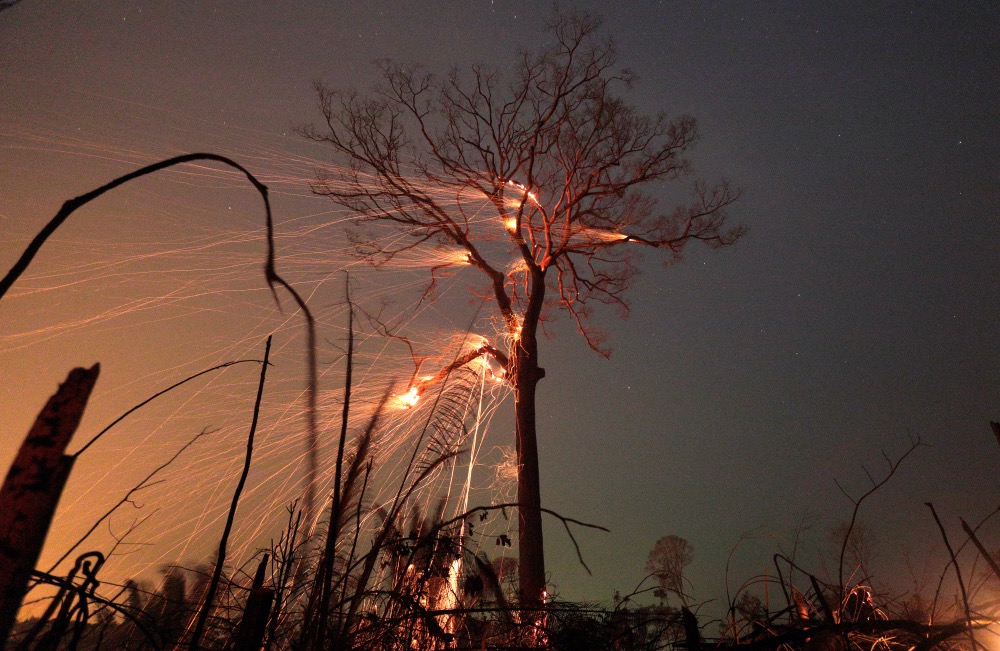Sao Paulo, Brazil
Thomson Reuters Foundation
Losses of Amazon rainforest are helping drive increasingly severe droughts in southern Brazil and Argentina that are contributing to surging wildfires there this season, a Brazilian scientist said.
More than three million hectares of land have burned this year in Brazil’s wildlife-rich Pantanal, a tropical wetlands that normally alternates between periods of flooding and drought each year.

A tract of Amazon jungle burns as it is cleared by farmers in Rio Pardo, Rondonia, Brazil, on 15th September, 2019. PICTURE: Reuters/Ricardo Moraes/File photo.
Fires have also raged for months through Argentina’s Parana Delta wetlands, with smoke choking nearby cities and walls of fire visible from urban areas.
The increasingly severe drought behind the fires has its origins in the Amazon, said Pierre Girard, a hydro-ecologist at Brazil’s Federal University of Matto Grosso, located in one of the states that contain the Pantanal.
The vast Amazon forest, he said, generates much of the rain that falls in the west and south-east of Brazil. Water vapor rises from the moist forest and is carried by the wind in a phenomenon known as a “flying river”.
But as the forest becomes smaller and more fragmented, it can produce less of the rain that other parts of Brazil – and Argentina – depend on.
“Burning the forest has an impact on the wetlands” – and potentially on food production in Brazil’s rich southern breadbasket, Girard said.
Pantanal ablaze
Data from LASA, the Laboratory for Environmental Satellite Applications at the University of Rio de Janeiro, shows the area burned in the Pantanal has more than doubled so far this year compared to 2019.
Altogether, nearly a quarter of the Pananal – home to jaguars, giant river otters, rare hyacinth macaws and the maned wolf, among other rare species – has burned this year, the laboratory said.
The civil police of Matto Grosso state have opened an inquiry into the cause of the fires, with preliminary findings naming intentional fire-setting to clear land for cattle grazing, sparks from electrical wires and a fiery car crash among the causes.
According to fire monitoring data from the Instituto Centro de Vida, an environmental non-profit working in Matto Grosso, the number of “hot spots” detected in the Pantanal hit 4,200 this August, compared to 184 in August last year.
In the first 20 days of September, the number of presumed fires rose to 5,100, up from 800 last September.
Girard said setting of fires to clear pastures is an old and annual practice in the Pantanal – but lengthening droughts have made the fires much more dangerous.
Problem wildfires used to happen every four to seven years, he said, but are now much more frequent.
The rising risks have been evident for at least 10 or 15 years, he said – though the data show a slow drying pattern dating back to the 1970s.
“A scary thing”
Ana Maria Barretto, a Pantanal farmer with 23,000 of her 25,000 hectares of land preserved as nature, said fires swept most of her property over the first two weeks of August, torching native forest and burning monkeys and snakes.
Her cattle managed to escape to other farms, she said.
“What I saw was a scary thing,” she said in a telephone interview.
Vinícius de Freitas Silgueiro, a forest engineer who works at the Instituto Centro de Vida, said satellite data showed fire swept through nearly 22,000 hectares – 87 per cent – of Barretto’s farm.
The small Perigara Territory of Indigenous Bororo people, whose land adjoins Barretto’s, was also destroyed by the fire.
Silgueiro said 80 per cent of their nearly 11 hectares of land burned.
Barretto attributed the disaster to a lack of rainfall this year and in recent years.
“In January, the cattle did not leave the wetlands, because it didn’t flood,” she said. “What should have spent six months inundated stayed only two months”.
Her ranch is home to a substantial population of blue hyacinth macaws, a species on the International Union for Conservation of Nature’s “red list” of threatened species.
Research done in 2013 to 2015 showed about 15 per cent of the world’s remaining thousand hyacinth macaws – or 150 birds – lived on Barretto’s land.
One of the authors of that study, Pedro Scherer-Neto, an ornithologist who monitors macaw populations, said the number of the rare birds had been growing on the farm, with about 700 to 800 living there before this year’s fires.
He said he had not yet determined how badly the birds were affected by the fires.
Girard, the ecologist, said with deforestation growing in the Amazon, “this recurrence of fires in the Pantanal is likely to increase”.
“On the one hand, we have climatic and [grassland] terrain conditions very favourable to fire, and on the other hand a political attitude very prone to fire,” he said.
Destruction of the Amazon surged to an 11-year high in 2019 and continues to climb in 2020, a change environmentalists blame on the policies of right-wing President Jair Bolsonaro, who has emboldened illegal loggers, miners and ranchers.
Bolsonaro has called for more farming and mining in protected areas of the Amazon forest, saying it is the only way to lift the region out of poverty.
Girard said there was little evidence of federal fire-fighting efforts this year in the vast Pantanal, parts of it a UNESCO World Heritage site.
“There was no reaction from the federal government at all,” he said. “So far, I haven’t seen much movement to help the Pantanal.”
The Ministry of the Environment did not respond to repeated questions about how the Pantanal fires had been handled.





